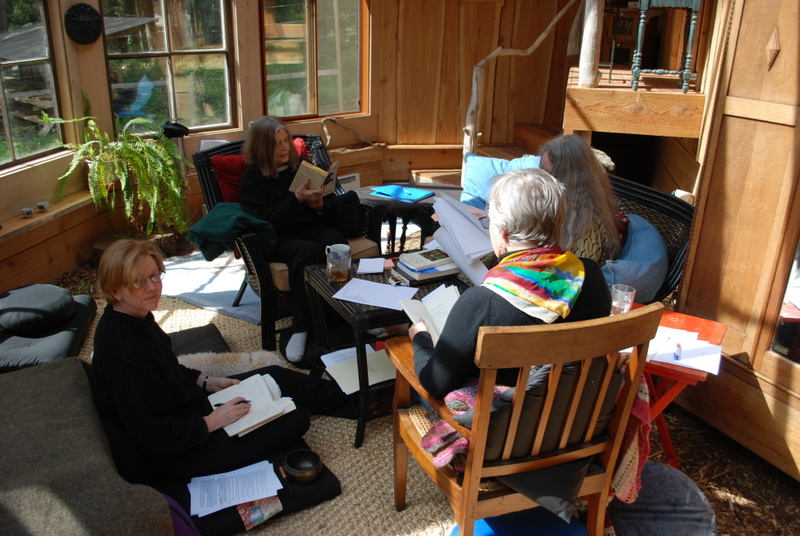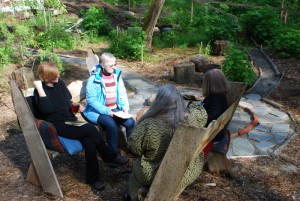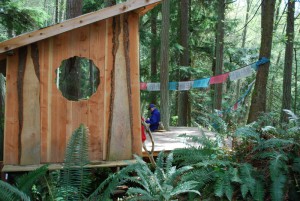Holding Earth Sangha Connects with the Earth and Evolves Buddhist Forms
Written by: Laurel Vogel

Author Laurel Vogel, seated on floor, participates in a writing workshop framed by the Greendo’s windows, with Karen Smith, Summer Graef (workshop leader), and Pat Renaud.
Holding Earth Sangha both honors and plays with Buddhist forms. Exploratory in nature, we gather along the edges, share leadership, and create bubbles of subversion in the smooth Zen facade. Our practice group, which we call an ecosangha, evolved within us as we started building our home on South Whidbey Island two years ago.
In a forest setting among cedars and firs, our rustic facility hosts a sitting practice group, writing workshops, and prayer circles, the latter led by Christopher Diggins. He is my husband and partner in Holding Earth, and a psychotherapist in Seattle who uses a mindfulness practice in his work.
With an upper limit of about 15 people at our facility, Holding Earth Sangha emphasizes practices designed to create stillness while moving the body, revealing how immersion in nature transmits Buddhist teachings.

Seated in the outdoor prayer circle, Laurel Vogel and Karen Smith, Summer Graef and Pat Renaud discuss writing.
At the center of our facility and supporting it is what we call a “Greendo,” a crescent –shaped addition to our home that started out as a greenhouse but evolved into place for meditation and teaching, like a zendo. The structure’s walls are mostly glass, and in the Greendo the barrier between indoors and outdoors is thin.
Easily transitioning from the Greendo to a nearby outdoor prayer circle, our barrier-free practices include circumambulations of the forested hill with stations for practice and meditation, outdoor meditation, and slow, meditative walking. We also conduct nature therapy retreats for couples, and a monthly ecumenical prayer circle.
Starting Holding Earth Sangha came naturally, because I had been thinking for many years about how to engage the outdoors with my work. The earth had always been a primary teacher for me, and as my Buddhist practice matured I discovered how connected the dharma was with nature. The more my husband and I allowed both dharma and earth to interact and teach us, the more we felt the reciprocity of the healing realtionship between them. Thus we use the word ecosangha. Eco is to encounter, practice with, and experience our interbeing with nature, and sangha is to join with others for exponential, surprising and authentic learning experiences.
Vietnamese teacher Thich Nhat Hanh describes our vision elegantly, when he says we are not separate from Earth: “You carry mother Earth within you. She is not outside of you. Mother Earth is not just your environment.”

A hike away from the main building, the forest hut is embraced by the trees.
Countering the language of separation, our ecosangha is an invitation to others to come and listen to nature’s voice as we open and receive subtle resonances through meditative practice. Zen teacher Norman Fischer first made me aware that non-separation means intimacy with everything.
Touching the Earth is a major component of our services and practices. Socially engaged Buddhism will also be a core work of our sangha, as we grow and have more hands, and our primary service will be restoring damaged natural areas.
But it’s important for us to also have fun. We hope to find ways to create energy that inspire us to care for our Earth and ourselves, and we hope to reinvigorate the real intention behind Buddhist practice.
“So to breathe in and be aware of your body and look deeply into it, and realize you are the Earth and your consciousness is also the consciousness of the Earth,” says Thich Naht Hanh. “Not to cut the tree, not to pollute the water, that is not enough.”
Hanh’s clear sentences cut to the core of how we are in jeopardy. Only through meaningful practices that offer deep insight into the nature of greed, hatred and delusion, will we end the suffering that continues to unfold as a global illness.
“It is possible to have real communication with the Earth, which is the highest form of prayer,” says Thich Naht Hanh. “In that kind of relationship you have enough love, strength and awakening in order to change your life.” Holding Earth Sangha carries this intention forward in our own small way.
At our most recent prayer circle we were honored to be led in Si.si.wiss practices based on the work of Johnny Moses, and in our next prayer circle, we will be emphasizing prayers in the form of song or music. In June we will be joining with Occupy Your Bike for a mindfulness ride to the beach for outdoor meditation, which will include a reading from Eihei Dogen’s Mountains and Rivers Sutra.
Our favorite way of practicing is to join with other groups and teachers and host half-day and daylong events, with the option of adding our unique practices. Buddhist writing retreats are especially encouraged and welcome.
We cannot accept overnight guests, but are situated between two retreat facilities, and there are many pleasant overnight options in the area, including some camping possibilities.
